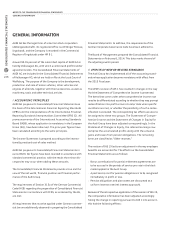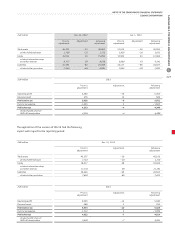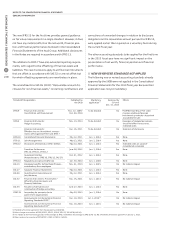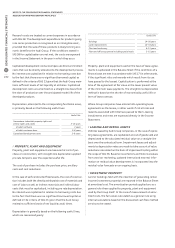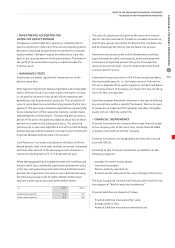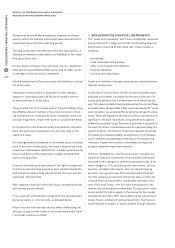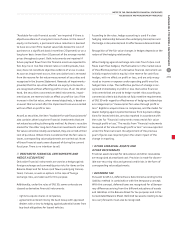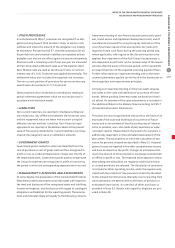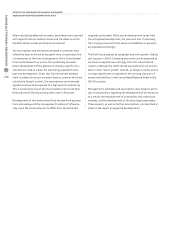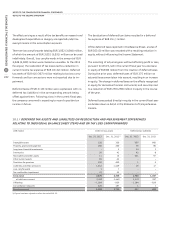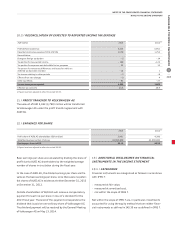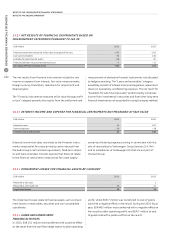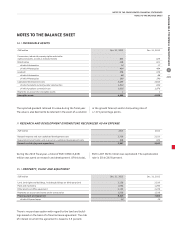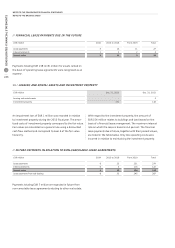Audi 2013 Annual Report Download - page 239
Download and view the complete annual report
Please find page 239 of the 2013 Audi annual report below. You can navigate through the pages in the report by either clicking on the pages listed below, or by using the keyword search tool below to find specific information within the annual report.
NOTES TO THE CONSOLIDATED FINANCIAL STATEMENTS
RECOGNITION AND MEASUREMENT PRINCIPLES
CONSOLIDATED FINANCIAL STATEMENTS
236
B
Deferrals amounting to the anticipated tax burden or tax relief
in subsequent fiscal years are created on the basis of the antic-
ipated tax rate at the time of realization. In accordance with
IAS 12, the tax consequences of distributions of profit are not
recognized until the resolution on the appropriation of profits
is adopted.
Deferred tax assets include future tax relief resulting from
temporary differences between the carrying amounts in the
Consolidated Balance Sheet and the valuations in the Balance
Sheet for tax purposes. In addition, deferred tax assets relat-
ing to tax loss carryforwards that can be realized in the future
and deferred tax assets from tax relief are also recognized.
Deferred tax assets and deferred tax liabilities are netted if the
taxable entities and maturities are identical.
Pursuant to IAS 1, deferred tax is reported as non-current.
The carrying amount is reduced for deferred tax assets that are
unlikely to be realized.
/
INVENTORIES
Raw materials and supplies are measured at the lower of aver-
age cost of purchase or net realizable value. Other costs of
purchase and purchase cost reductions are taken into account
as appropriate.
Work in progress and finished goods are measured at the lower
of cost of production or net realizable value. Cost of conversion
includes direct materials and direct productive wages, as well as
a directly attributable portion of the necessary indirect mate-
rials and indirect labor costs, scheduled production-related
depreciation, and expenses attributable to the products from
the scheduled amortization of capitalized production devel-
opment costs. Distribution costs, administrative expenses and
interest on borrowed capital are not capitalized.
Merchandise is measured at the lower of cost of purchase or
net realizable value.
Provision is made for all discernible storage and inventory risks
in the form of appropriate reductions in the carrying amounts.
Individual adjustments are made on all inventories as soon as
the probable proceeds realizable from their sale or use are
lower than the carrying amounts of the inventories. The net
realizable value is deemed to be the estimated proceeds of
sale less the estimated costs incurred up until the sale.
Current leased assets comprise leased vehicles with an operat-
ing lease agreement of up to one year and vehicles which are
subject to a buy-back obligation within one year (owing to buy-
back agreements). These vehicles are capitalized at cost of
goods sold and measured in accordance with the expected loss
of value and likely useful life. Based on local factors and his-
torical values from used car marketing, updated internal and
external information is incorporated into the measurement on
an ongoing basis.
/
SECURITIES, CASH AND CASH EQUIVALENTS
Securities held as current assets are measured at market value,
i.e. at the trading price on the balance sheet date. Cash and cash
equivalents are stated at their nominal value. The cash figures
encompass cash and cash equivalents. Included under cash
equivalents are financial resources that are highly liquid with
an insignificant risk of fluctuations in value.
The Audi Group is integrated into the Volkswagen Group’s
financial management. As part of cash pooling arrangements,
balances are settled on a daily basis and transformed into
amounts owed to or from Volkswagen AG. This promotes the
efficiency of both intra-Group and external transactions and
also reduces transaction costs. The cash pool receivables are
allocated to cash and cash equivalents on the basis of their
character as cash equivalents.
/
PROVISIONS FOR PENSIONS
Actuarial measurement of provisions for pensions is based on
the projected unit credit method for defined retirement benefit
plans as specified in IAS 19 (Employee Benefits). This method
takes account of pensions and entitlements to future pensions
known at the balance sheet date as well as anticipated future
pay and pension increases. The actuarial interest rate continues
to be determined on the basis of profits realized on the capital
market for top-ranking corporate bonds. The individual param-
eters used to measure provisions for pensions are described in
Note 31. Actuarial gains or losses are reported in equity as
retained earnings, with no effect on profit or loss, after taking
deferred tax into account.


